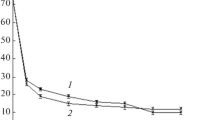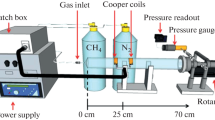Abstract
Contact angle data, measured by using a sessile drop arrangement in conjunction with Axisymmetric Drop Shape Analysis-contact Diameter (ADSA-CD), were used to quantify the effects of ammonia gas plasma treatment on the surface properties of previously untreated polystyrene surfaces. The surface tension of treated polystyrene samples is considerably higher than that of untreated samples. The increase in surface tension following plasma treatment is attributed to the addition of amine groups to the surface.
Next, conformational changes following the attachment of poly-L-lysine to the untreated samples by simple adsorption and plasma treated samples by covalent bonding were investigated. Surface tension values obtained from contact angle data indicate that conformational changes to poly-L-lysine occur in both cases, because these values are lower than the surface tension of poly-L-lysine in solution. However, contact angle data show that covalently bonded poly-L-lysine undergoes less conformational changes than simply adsorbed poly-L-lysine.
Similar content being viewed by others
References
Baier RE (1977) Ann NY Acad Sci 283:17
Vroman L, Adams AL, Klings M (1971) Fed Proc 30:1494
Iordanskii AL, Zaikov, G Ye (1983) Polym Sci USSR 25:523
Morrissey BW (1977) Ann NY Acad Sci 283:50
Jauregui HO (1987) ASAIO Trans 33:66
Sipehia R, Chawla AS, Daka J, Chang TMS (1988) J Biomed Mater Res 22:417
Hoffman AS, Schmer G, Harris C, Kraft WG (1972) ASAIO Trans 18:10
Nguyen AL, Wilkes GL (1974) J Biomed Mater Res 8:261
Skinner F, Rotenberg Y, Neumann AW (1989) J Colloid Interface Sci, 130:25
Duncan-Hewitt WC, Policova Z, Cheng P, Vargha-Butler EI, Neumann AW (1989) Colloids and Surfaces 42:391
Vogtle JW (1989) M.A.Sc. Thesis, University of Toronto, Toronto, Canada
Vandenberg ET (private communication)
Ward CA, Neumann AW (1974) J Colloid Interface Sci 49:286
Neumann AW, Good RJ, Hope CJ, Sejpal MJ (1974) J Colloid Interface Sci 49:291
Cheng P, Li D, Boruvka L, Rotenberg Y, Neumann AW (1990) Colloids Surfaces 43:151
Neumann AW (1974) Adv Colloids Interface Sci 4:105
Yasuda H, Marsh HC, Brandt S, Reilley CN (1977) J Polym Sci 15:991
Sipehia R, Chawla AS (1982) Biomat Med Dev Art Org 10:229
Neumann AW, Moscarello MA, Epand RM (1973) Biopolymers 12:1945
Author information
Authors and Affiliations
Rights and permissions
About this article
Cite this article
Moy, E., Lin, F.Y.H., Vogtle, J.W. et al. Contact angle studies of the surface properties of covalently bonded poly-L-lysine to surfaces treated by glow-discharge. Colloid Polym Sci 272, 1245–1251 (1994). https://doi.org/10.1007/BF00657777
Received:
Accepted:
Issue Date:
DOI: https://doi.org/10.1007/BF00657777




